-
Notifications
You must be signed in to change notification settings - Fork 51
004 The Tap List
This list contains a large library of images and details on "RF Taps" community members have done to get signals out of there VCRs, VTRs, Camcorders & Open-Reel systems for FM RF capture, varying from probes to more permanent BNC installs.
Via posting your VCR setup in the DD86 Discord, Sub-Reddit or via emailing harry@opcomedia.com directly.
Important
For step by step instructions and general guidance on RF Tapping please read the Hardware Installation Guide.
There are 4 types of RF taps you will observe:
-
Test Point + Capacitor on a Bar/Floating-Bar/Poll/Hook Type Points.
-
2.54mm Header to DuPont Connector used on most Sony VCRs. Best Example
-
Jig-Hookup for some camcorders Video8/Hi8/Digital8 there is a 0.5mm pitch (16/18/20 Pin) ribbon cable slot as observed with the Sony DCR-TRV840 camcorder.
-
Direct Head Amplifier Tap see Panasonic NV-HS1000, NV-HS950B & AG-7150 for examples for this.
K-Mech S-VHS HiFi VCR 90s era
Note
The head amplification board may have cracked solder joints even if serviced the amplification module & shielding should be removed for inspection & properly reflowed with flux and 99% Isopropanol brushing clean the area if cracked like in the images.
4 Philips screws on the sides pull outwards and lift from the back sides, metal is stamped so be careful not to slice fingers by sliding them across the edge.
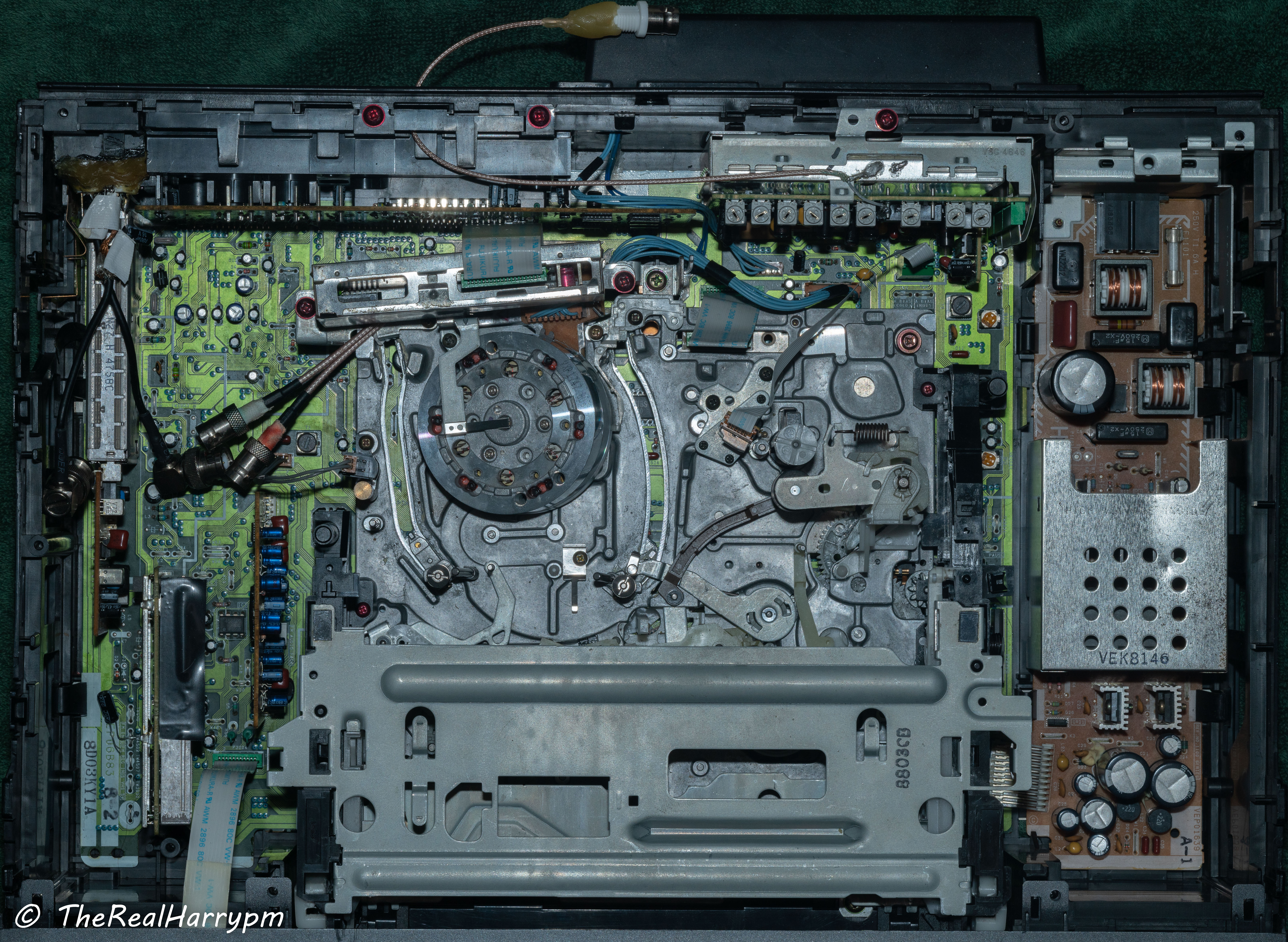

Standard test point tap this can fit a 25v 10uf cap nicely inside the removable TBC module easy access to a solder-able surface for grounding, then thread RG178 cable through the plastic mounting gap to a BNC.
Note
This is a direct tap testing deck, you do not need to directly tap the head amplifiers but if you do it will require a capacitor added in-line, and the pin wedge method will be easier.

-
Head Amplifier Board (Green Connector) Pin 10 Direct RF C (Tested Working VHS issues with SVHS) (Pin 11 does not work)
-
Head Amplifier Board (Green Connector) Pin 16 Direct Audio RF
Requires a 10uf capacitor in-line for SVHS RF captures on direct taps the signal is just too low otherwise.
-
Test Point TL3001 RF-C (VIDEO ENVE) Requires 10uf cap. (VHS/SVHS Work)
-
Test Point TP2001 RF Head Switching (H.SW)
-
Test Point TW4502 HiFi RF (Bottom Left Side)
-
Test Point TWGND Ground next to HiFi RF
K-Mech, the easiest tap point is the head amplifier, removal of the mainboard is ideal for adding BNCs for RF taps, but is quite a tight case.


From left to right:
-
Pin 4 is HiFi Audio RF
-
Pin 13 is Video RF
The pin tap method wedges the capacitor negative leg between the ribbon cable and the board connector, 3.3uf electrolytic tested and working well.

- TP1 ENV - Video RF
- Pin 4 of P4812 or Pin 16 of P4806 - HiFi RF

The AG1980P also has a dedicated head amplifier module that can be RF tapped directly for external amplifier use.



-
TP3301 ENV Test point on top of main PCB (which is RF C from head amp via 0.01 uf capacitor) - tested ok with DDD
-
todo: hi-fi
(Made by Orion?)
-
TP4002 Video Envelope
-
TP4001 Head Switching Pulse
Samsung made VCR Range late 90s and on (including early 2000s and later Sony)

Test points on Samsun SV-6213 with mechanical mechanism removed
Test points are typically wires with a hole underneath on the left side of the mechanism.
With the Domesday duplicator at least, it seems the test point ground doesn't work very well. So far I got the best result by connecting to the vcr mechanism chassis rather than the test point ground and putting a 0.1 uf film capacitor between the env wire and wire for capturing. May still need some more adjustments to work optimally but not sure.
-
TP301 ENV - Video RF
-
TP302 A-Out Audio Baseband
-
TP303 V-Out Composite Video
-
TP602 HD SW - Head Switching Signal
-
TP601 CTL - Control Track Signals
-
W022 GND - Grounding
HiFi RF Capture is not possible, due to the modern IC used.
Sony late 90s/early 2000s

Test points on connector with shielding around it behind head drum (CN262)
- PB RF - Video RF
- RF SWP - Head switching signal
- GND - Ground
- CTL - Control track signal
- AV ADJ - Pin used to activate head switch point adjustment
Separate 2-pin connector for FM audio right of mechanism (CN341 on SLV-SE60 and similar, C362 on SLV-SE800 and related, may be different on others)
- GND
- HF ADJ - Audio FM (Needs test)
DuPont Connector RF Tap Female Cable Link Male Cable Link
For the PAL variants at least, it seems these often have some capacitors in the power supply go bad, which can cause interference on image on normal playback, and failure to turn on depending on which ones are bad.

DuPont Connector RF Tap Female Cable Link Male Cable Link
- REC CUR (Current)
- PB RF - Video RF
- RF SWP - Head switching signal
- GND - Ground
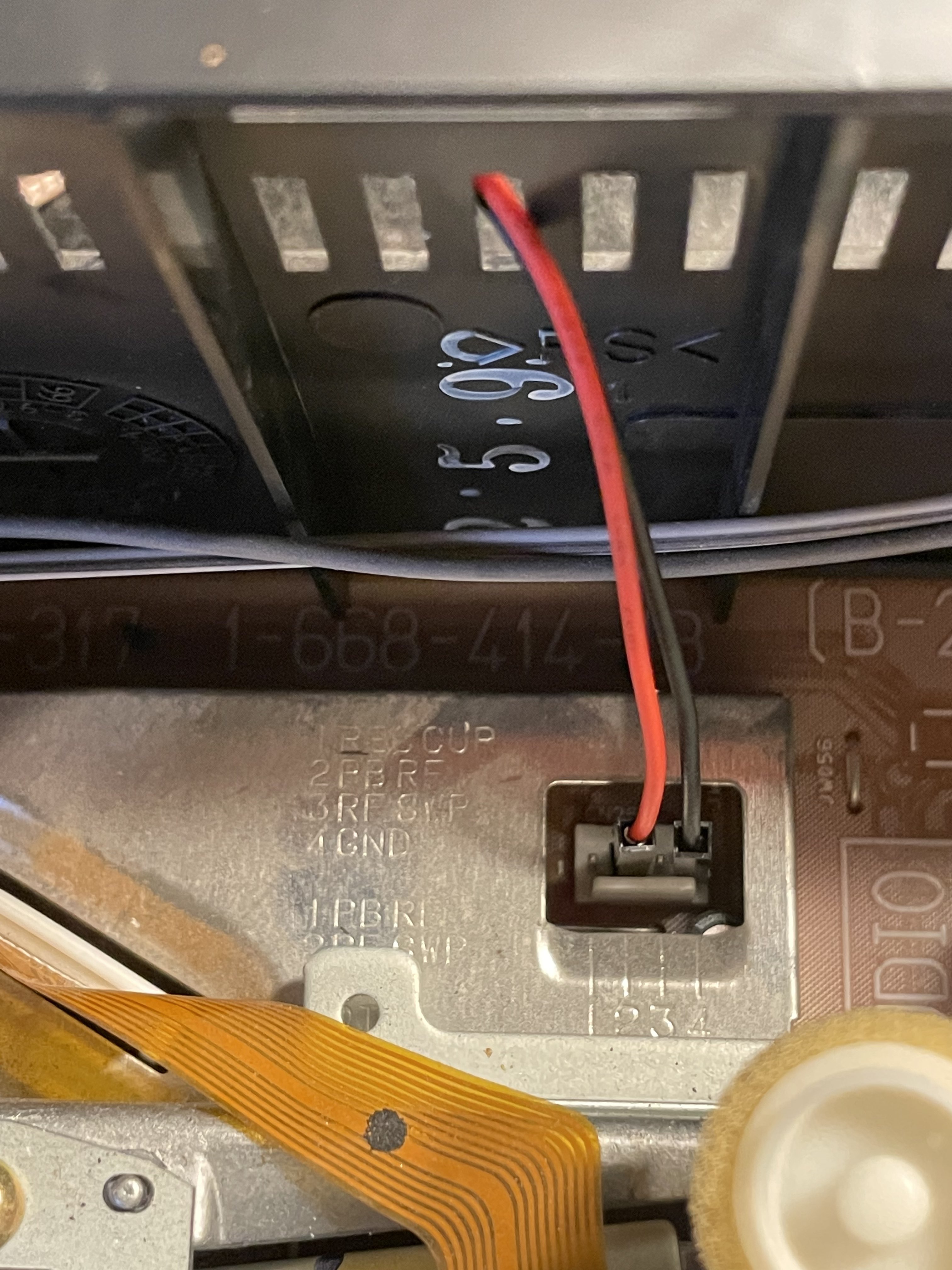

Top Board, Floating Bar Type Test Point
Mainboard Tap
J1261 ENV (Video RF)
J1264 GND (Ground)
Direct Head Amp Tap (Tested)
TP182 - Video RF
Shield - Ground
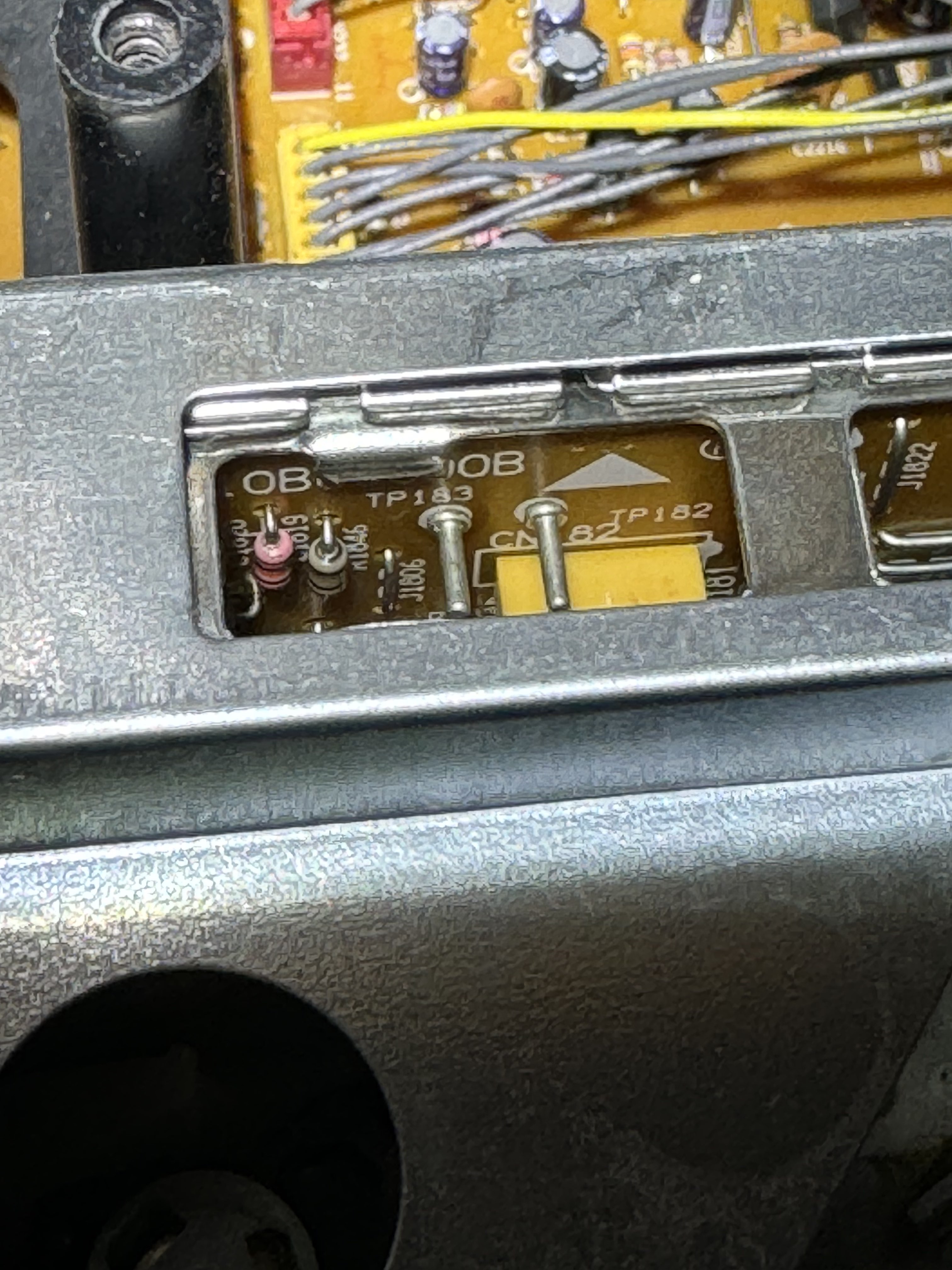




Head Amplifier board right to left order (based off expansion probe board)
- AFM PB RF
- Video CH-1 REC Current
- Video CH-2 REC Current
- Video PB RF Output
- RF Switching Pulse
- Ground




They have a dedicated header of test points called TP01
- V. Out - Composite Video
- A. Out - Baseband Audio Out
- V. ENV - Video RF
- H' D SW - Head Switching Signals
- CTL - Control Signals
- GND - Ground Pin
HiFi RF Capture is not possible, due to the modern IC used.
Test Points are left-hand side of the mainboard, using a floating bar style next to the TV pack.
- HiFi - HiFi RF
- H.SW - Head Switching Signals
- V. ENV - Video RF (Requires cap 10uf & 100uf tested)
- Service (Unknown Need to Check Service Manual)


Deck With mechanical and Fused IEC14 & BNC Bulkhead Mods

pal/secam/ntsc Thomson vp-4650
- PB_YC (PB On Board Label)

- Video PB TP6 (Test)
- HiFi - Currently Unknown
Due to the removable back service panel easy bulkhead space for BNC's.
Professional 3U Rackmount Player
Due to the removable back service panel easy bulkhead space for BNC's.

-
Video board 1, TP4 ENV - Video RF (works with and without caps good signal)
-
HiFi - Audio board A2 TP707 (TP4707 In manual) underneath plastic retaining clamp.

3D Printed Plate holding 2 standard BNC bulkheads.
Ideal for this deck due to wide space to deploy an ADA amplifyer with SMA connectors.



Most test points are accessible on the top board or underside of the board which flips out to the side, 10uf cap on Video test point clean and stable both RF and conventional, good S-VHS LP playback.
The RF Points can be accessed via the top or underside, you can also adjust the head switching position with ease during playback on this unit.
-
Video ENV TP1 (Top, the front side of the unit)
-
HiFi ENV TP5 (Top, the back side of the unit) (Filtered Output Not Usable)

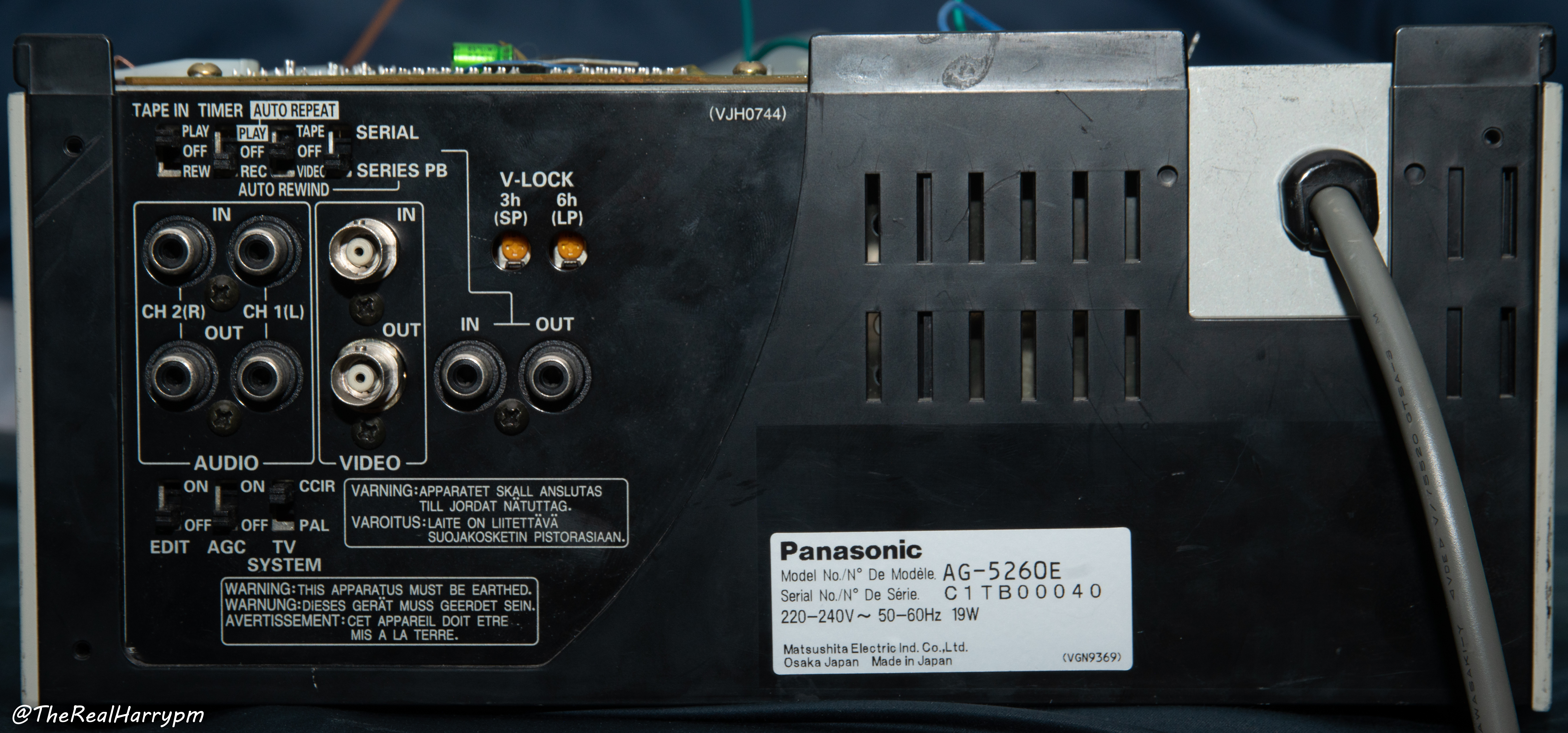

Direct Head Amp Taps are needed for full hifi, this allows this deck to do HiFi RF + Linear as audio output is selectable on the front panel.

 <img src="assets/images/vhs/Panasonic-AG5620/Panasonic-AG-5260_2023-12-06_16-32-33.jpg"
<img src="assets/images/vhs/Panasonic-AG5620/Panasonic-AG-5260_2023-12-06_16-32-33.jpg"
With the bottom of the shield corner being cut off there is enough space for RG178/RG316 routed out the testing cut out of the main PCB.
HiFi Output

Linear Only Output

Note
for NV-HD/NV-SD models, the non-European and multi-system variants are sometimes closer to the next year's central Europe variant with the same number (excl letter prefix).
- RF C TP TP3001 video RF (main board)
- RF TP4502 Hi-Fi RF (on head amp, not tested)


- RF C TP TW3001 video RF (upper left behind luma/chroma pack when seen from the front)
- RF - TP4502(on head amp) / TL4519 on hi-fi pack - Hi-Fi RF (don't remember which one I used)


NV-HD630, NV-HD630B etc
Z-Mech, Mostly easily accessible test points without mech removal needed, 10uf caps recommended and tested.
Marked in order

-
TW3001 RF C - Video FM
-
TW501 FM Mix Out - HiFi FM RF (On some decks?)
-
TW26 CVBS Out - Composite Video Output
-
TW3 CVBS Input - Composite Video Input
-
TW502 - ENVE (HiFi FM)


Ground is easily assessable via the TV pack or via pads under the HiFi tap (TW502) area.
Potless AD8367 & the current standard ADA4857 amplifier has been tested with CX Cards & DdD and work quite well yilding 40-44 dB Black SNR.
Note
CVBS/Composite Test Point is easy to add a BNC for standard CVBS out without using SCART, the TV modulation & demodulation pack can also be removed and replaced with header pins for easy 3/5/12v power and several points for ground.

- TP-3001 - Video RF
Note
No HiFi on this deck.
Unknown Tap Points to Update





- A.FM
- PB.FM
There is enough space for 2 BNC bulkheads next to the right side of the TV Modulation back.
- A.PB-FM TP2253 - HiFi FM
- PB-FM TP106 - Video FM





Note we have data & dumped EPROM chips for this VCR.




Note we have data & dumped EPROM chips for this VCR.
For hifi .01uf polymer capacitor.
For video .1uf polymer capacitor.



TP851 - PB ENV Directly On Head Amplifier Board

ENV is on a flat touch test point pad, easily solder able onto.



Test Points are off to the left side of the VCR next to the power supply shield.
Metal Chassis.
- TP1 - V-Out (CVBS)
- TP2 - A-Out (HiFi??)
- TP3 - ENV (Video FM RF)
- TP4 - H'D SW (Head Switching)
- TP5 - CTL (Control Track)
- TP6 - GND (Grounding)


DVD VHS Combo VCR
-
TW501 - FM Mix Out - HiFi FM
-
TW4502 - FM-ENV - Video FM



1997 era unit.
- TP3002 - Video FM RF
HiFi Unknown

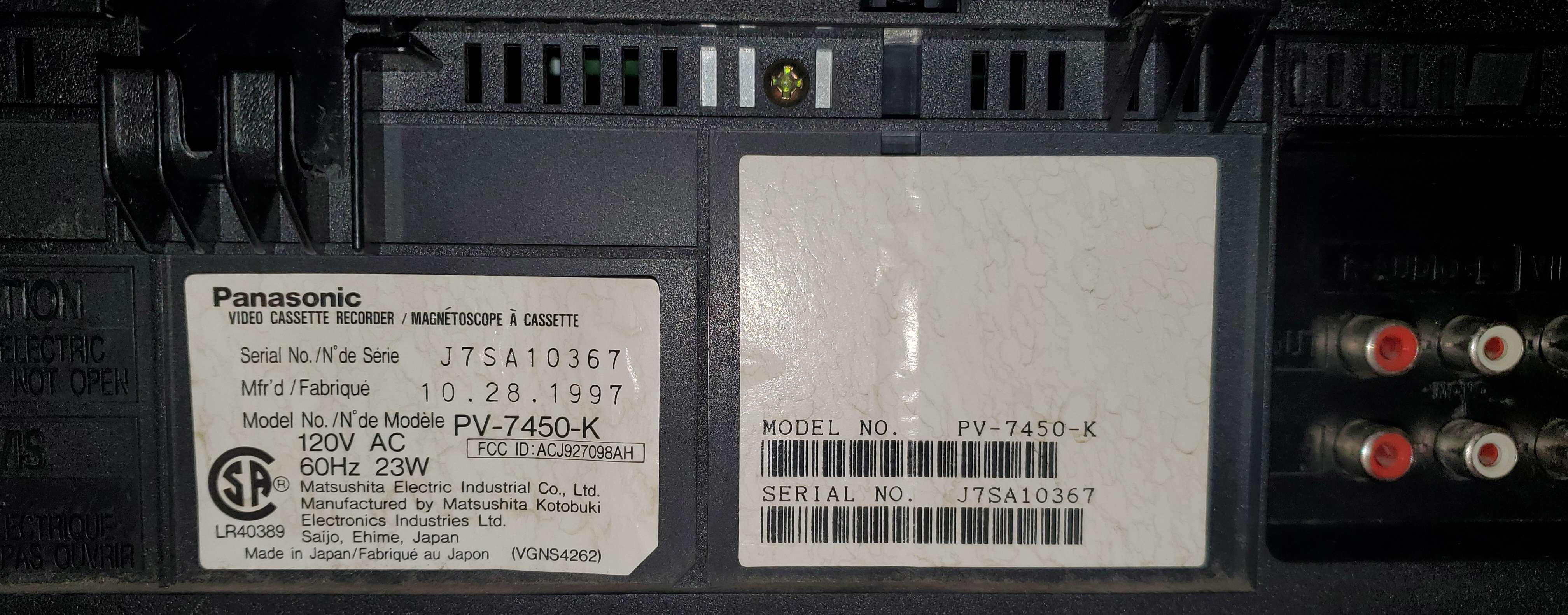
Panasonic PV-V4612S (Tested), PV-V402, PV-V4022, PV-V4522, PV-V4612
RF Tap: TP3002 (10uf/50v)
HIFI Tap: TP4207 (10uf/50v)



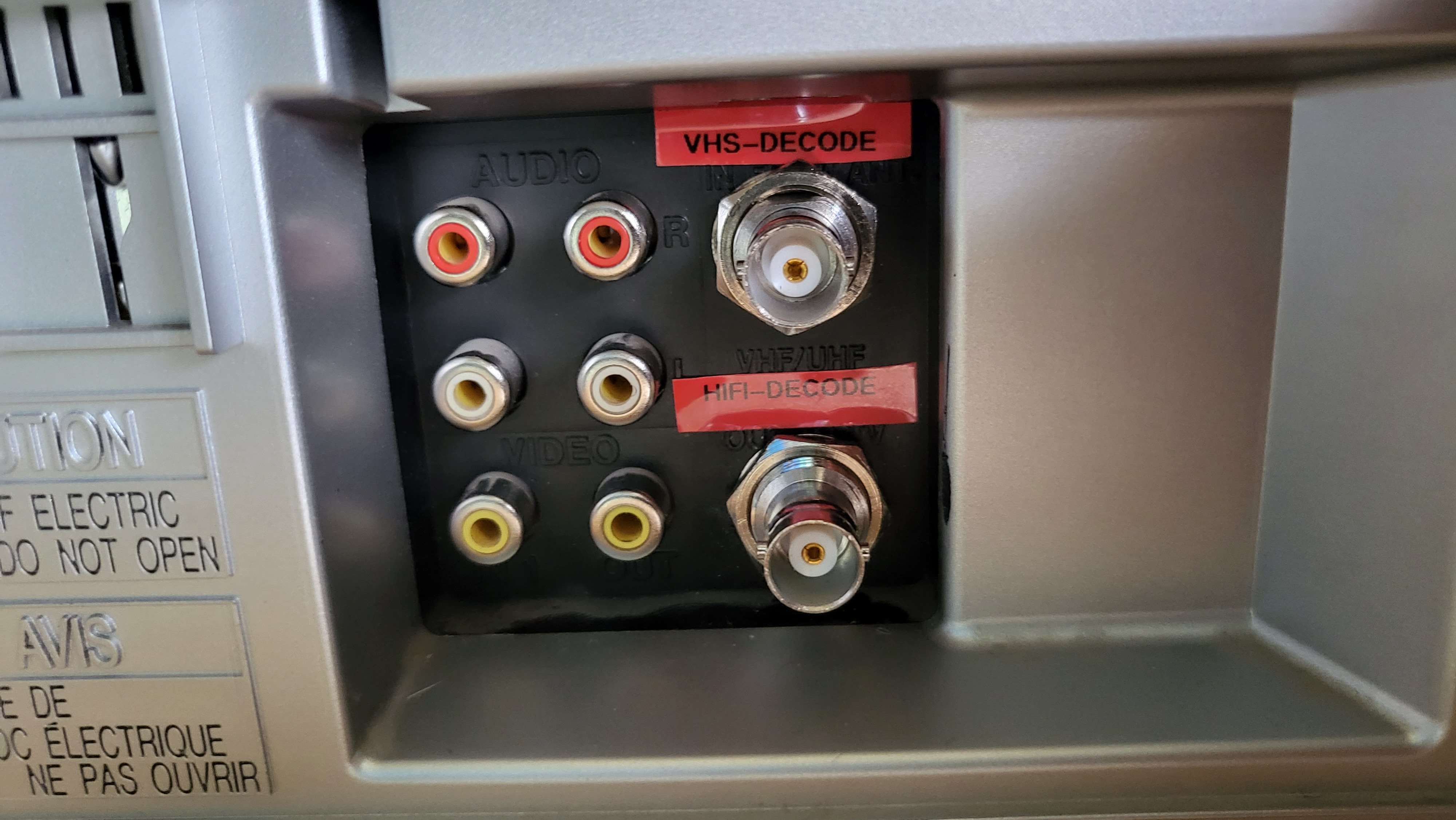
Video RF: TP106 PB FM
HiFi RF: TP2253 A.PB




CVBS Test Point: V.OUT W326
Audio Test Point: A.OUT W325
Video FM: ENV W324
Ground: W321


TP2253 A.PB.FM
TP106 PB.FM

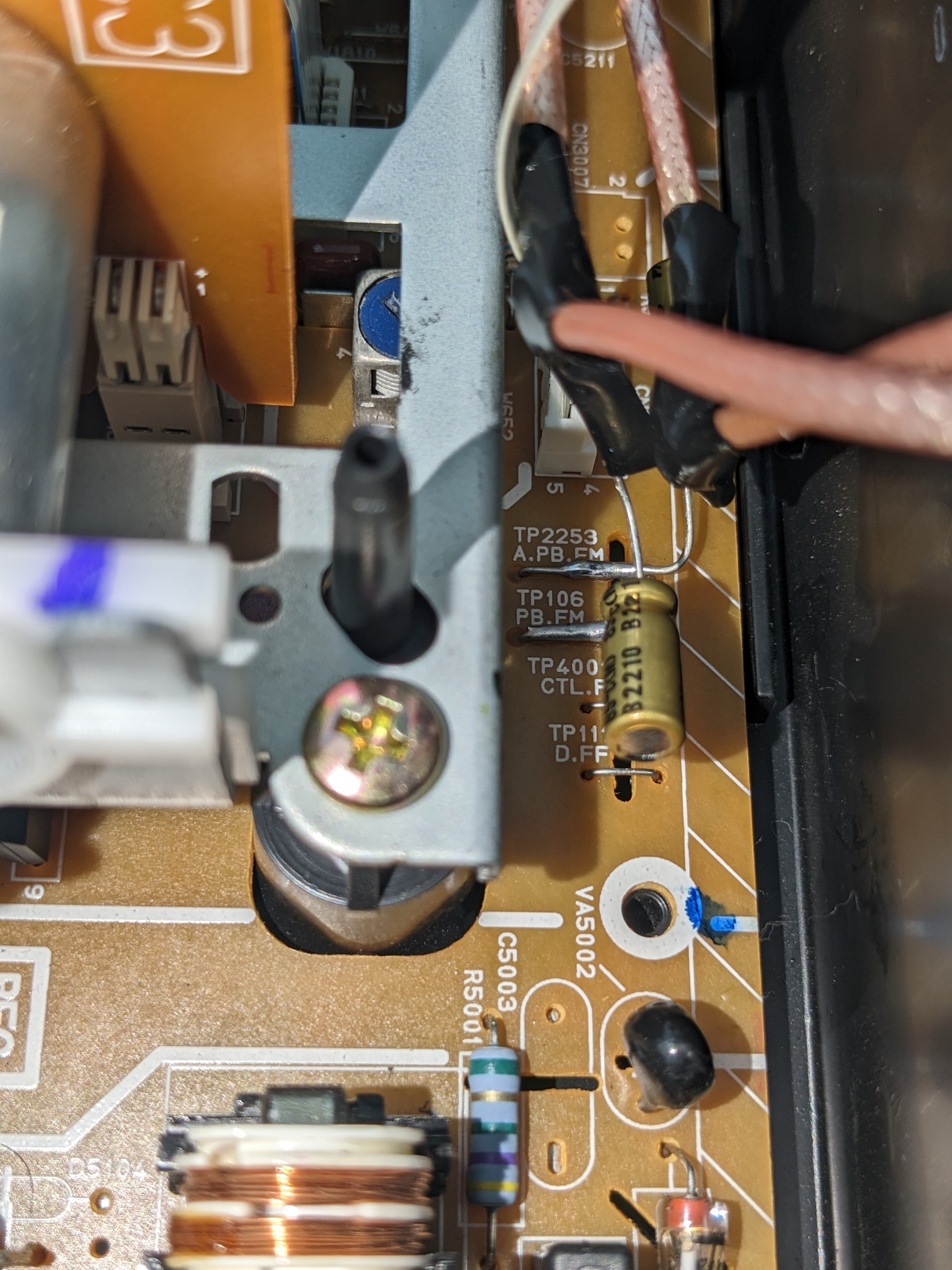

World Wide System VCR, Similar layout to NV-HS1000


SVHS / HiFi
TP3N/3 - Video RF
TP2A - HiFI RF


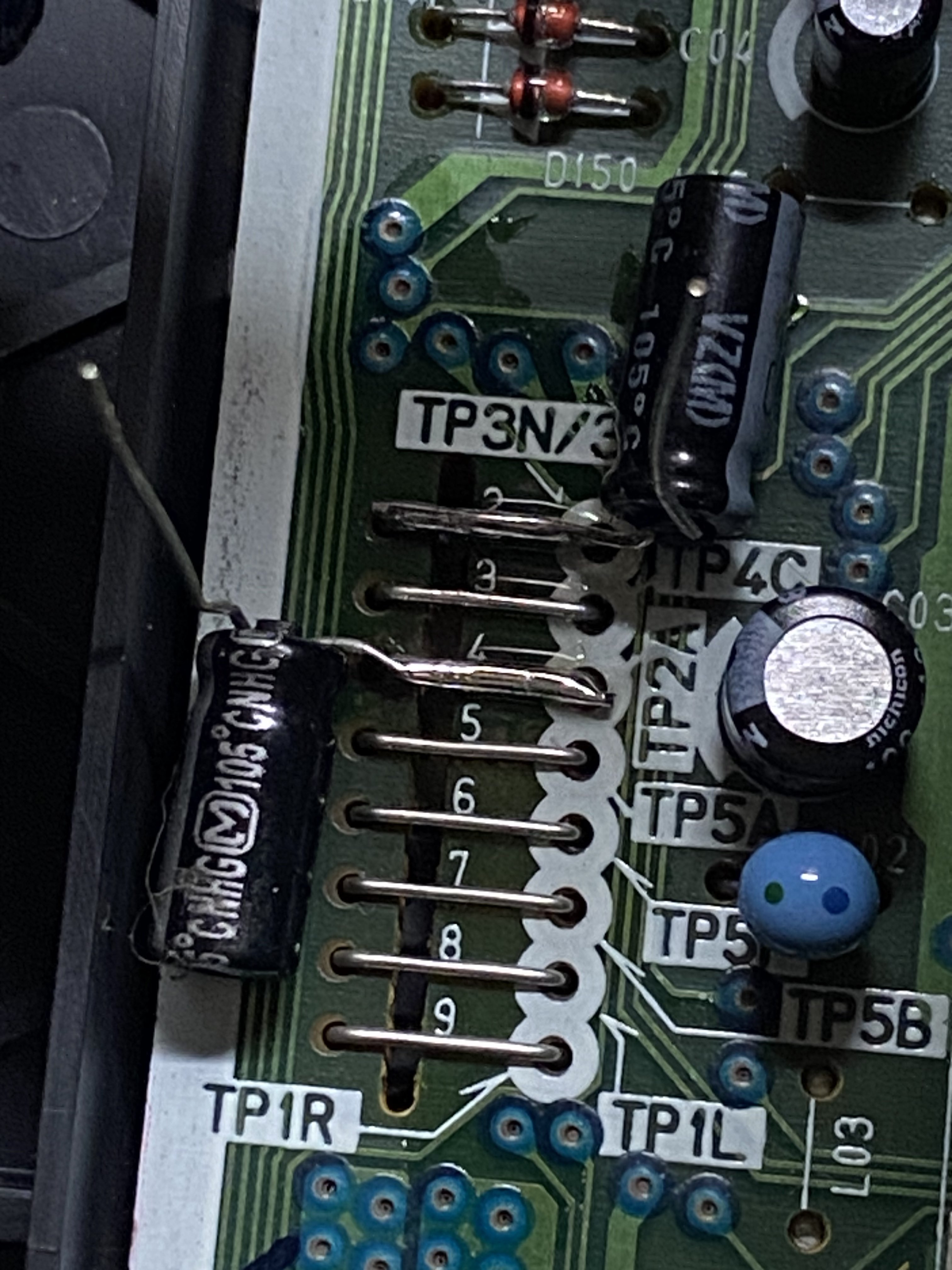


VHS HQ / HiFI
DuPont Type Test Header at back of unit, vents and blank area available for BNCs

E 5v - JP508
P/ADJ - JP507
ENVE - JP506
H/SW - JP505
CTL - JP504
GND - JP503
Video - JP502 (CVBS Output)
Audio - JP501 (HiFi??)
SCART / RCA Outputs



Rebadged Panasonic HS1000
SVHS / HiFi
TP1: Video RF






Test points on head amplifier unit
- TP182 - Video RF
- TP183 - Head switch
Most Sanyo/Fisher decks from the early-mid-late 90s use similar setups with video rf pin test point easily accessible on the head amp unit
Audio RF does not have a separate test point
TP 310 - C-PB
J28 - Ground





Video RF - TW3001




Video RF - TP3002 (tested working well without cap needed)
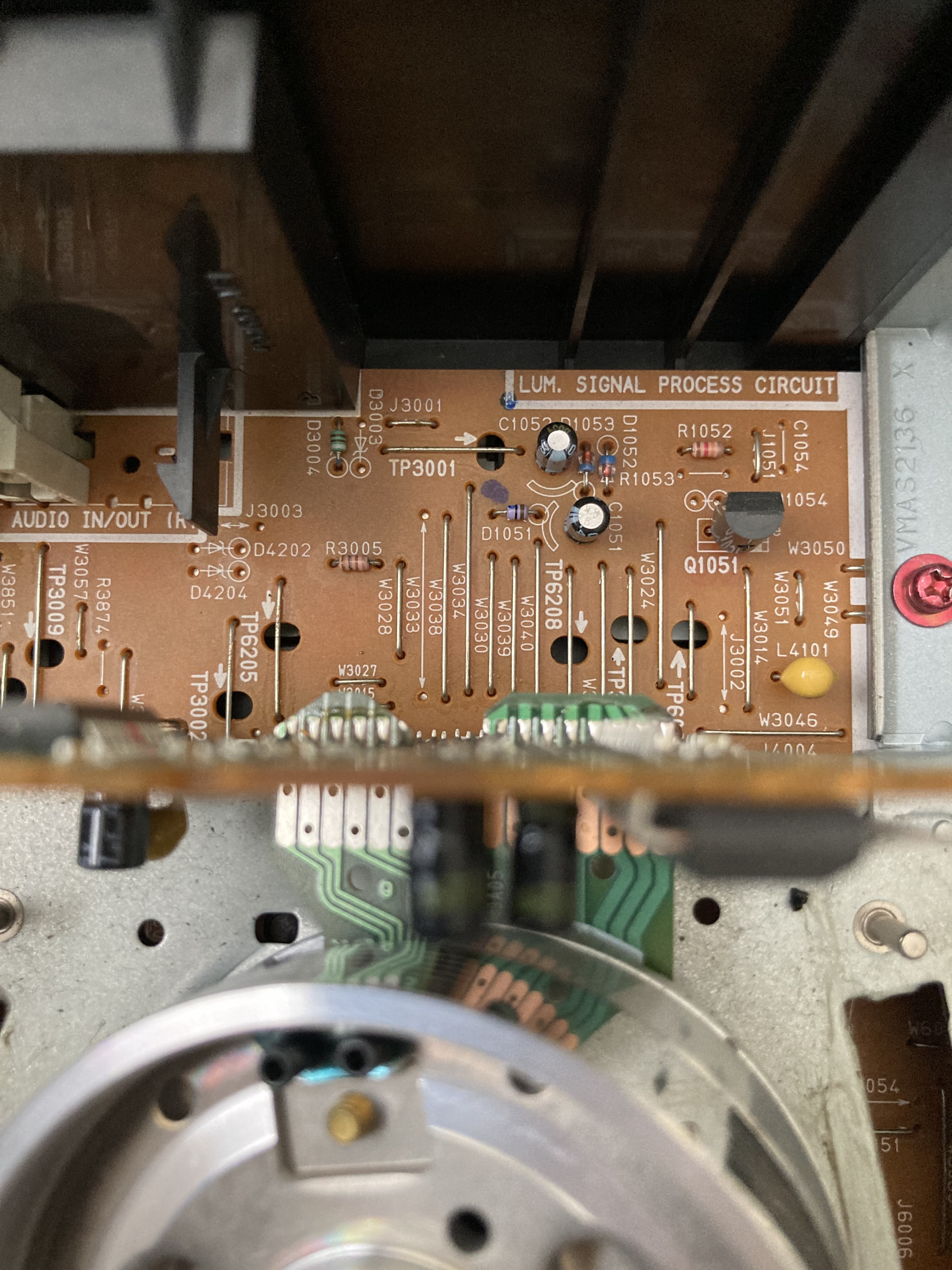
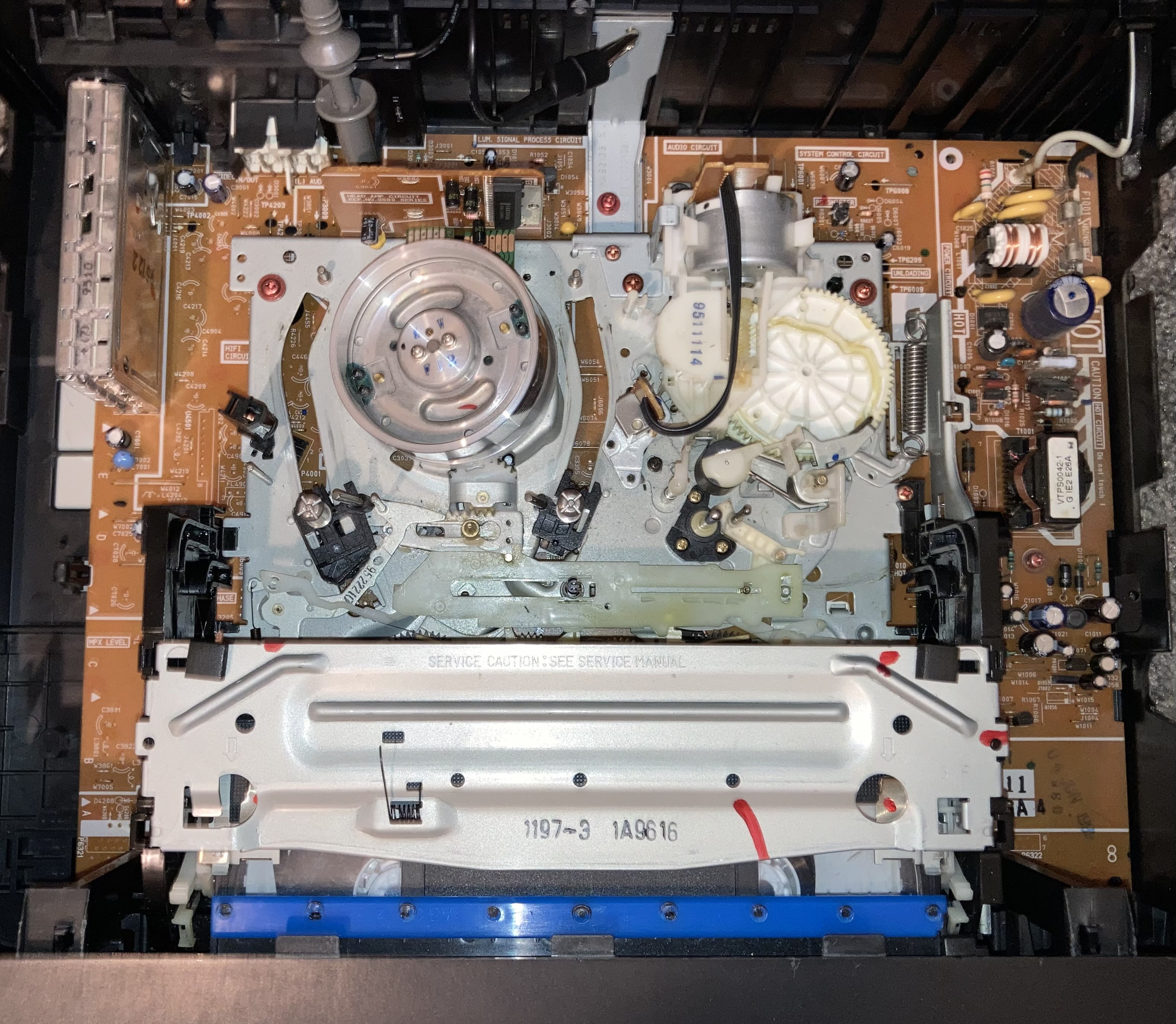


Floating Bar style
TP3 - ENV (Video RF) W216 - GND TP1 - V-Out (CVBS)





Top Left Test Points
TP3N - HiFi RF
TP5C1 - Video RF


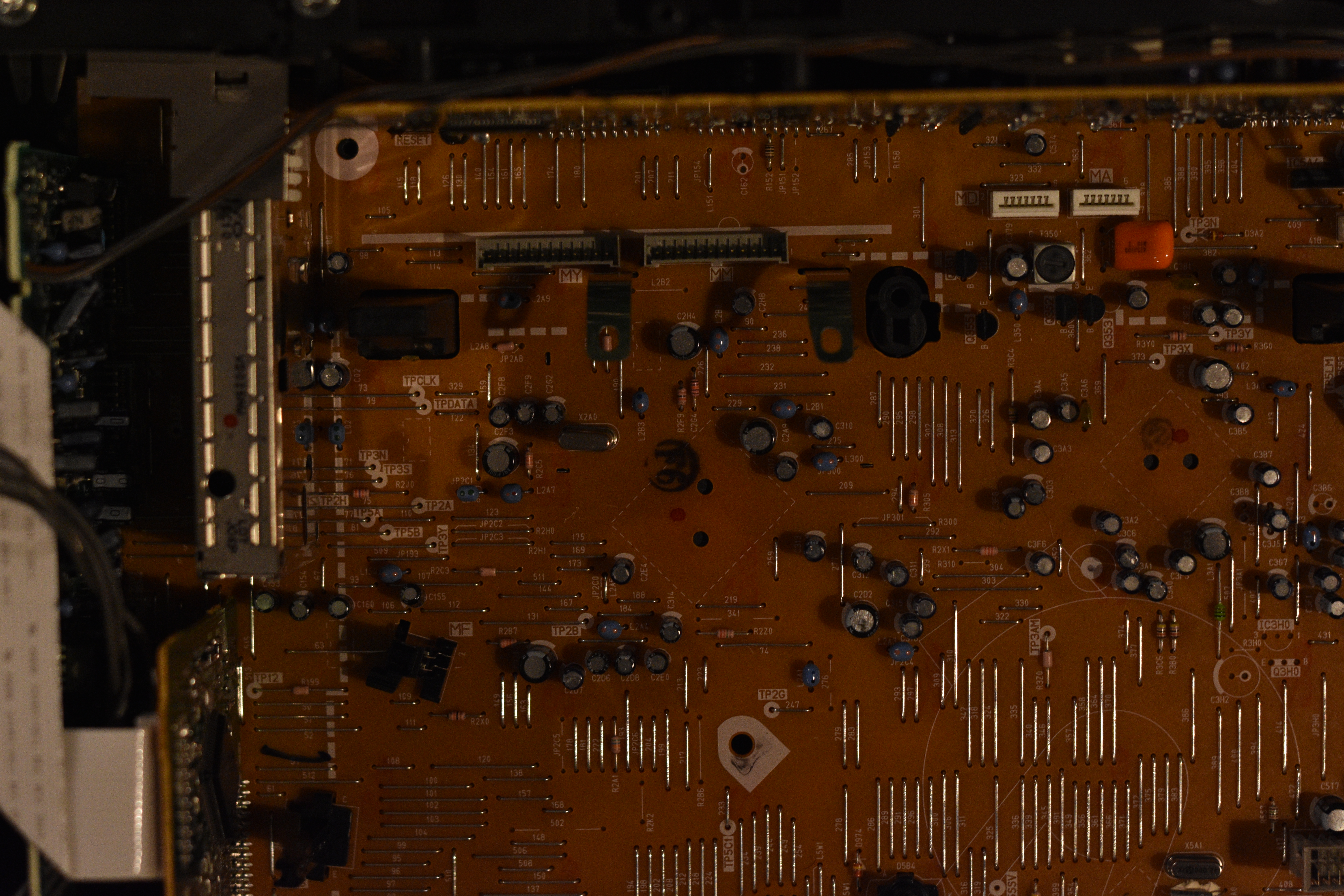
2.54mm DuPont headder test point
It's a Brazilian JVC rebranding. An easy RF Tap, just find the PT01 connection, then use the 1st pin as ground and the 4th pin is the RF Tap. The arrow indicates the first pin.
There are some holes on the chassis that help getting the cables out and making a better structure for the RF Tap.




W359 / W360 Video RF
HiFi RF below
TOSHIBA-VCX689-VC-X690-VC-X794

This is the same as most consumer decks but you have an IEC13 with a proper grounding lug, ideal for running your BNCs ground to.
Photo 3, center of image,
TW2 ENVE Out - Video RF
TW1 FM Mix - HiFi RF



TP3002 for video FM RF.



Tested with 36-40db bSNR with an old and repeatedly played lady and the tramp VHS tape, no amp nor capacitor
TP3002 for video FM RF left hand side, easy to remove TV pack via de-soldering.


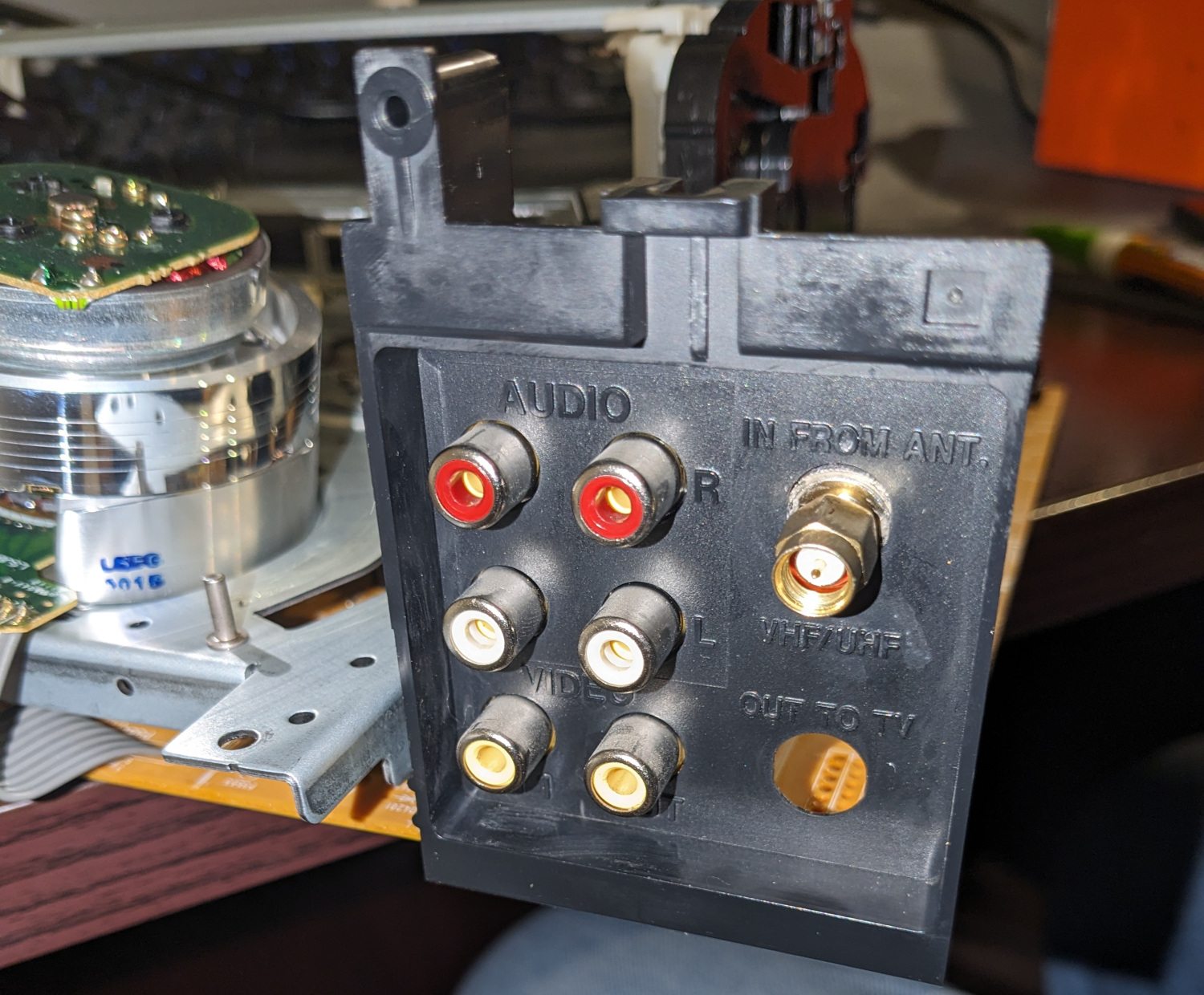
Has full Video RF on "RF Out" but is not very good SNR on testing sadly


Also MV40 etc
Test points top left of mech
PB FM - TP106 - Video RF
A.PB FM - TP2253 - HiFi RF


5-pin 2.54mm DuPont header connector P506
Pin 4 = GND Pin 5 = ENV / PB RF


HiFi audio is to the left of RF Video.
HiFi audio is point 2 for ground, point 3 for RF.
RF Video is point 3 for RF, point 4 for ground.

HiFi Tap:

Vide RF:

Combo Decks or Combination decks fall into 3 types in the standard 19" chassis frame.
MiniDV & VHS / Video8/H8 & VHS / DVD/BluRay & VHS
DdD used for testing to capture the Video RF
DdD gain on the VHS part was set to maximum (8), which resulted in ~0.5 maximum amplitude (measured in Audacity)
DdD gain on the Video8 part was set to 4, which resulted in ~0.8 - 0.9 maximum amplitude (measured in Audacity)
Black SNR on old (1986 - 2000) Video8-tapes was up to 50 dB in some cases, lowest was ~44dB
100 uF electrolytic capacitor in line with the SMA-cable and did not solder it directly to the VCR
Output Impedence:
Sony SLV-T2000 VHS = 1 kOhm
Sony SLV-T2000 Video8 = 200 Ohm
For VHS Audio two pins need to be soldered to the rear of the RV-50 board.










Test Point on the top right hand side of the mech, pads style test point.



TW4501 - FM Mix Out (HiFi RF)
PB-FM ENV - (Video RF)
Left-hand side back of the mech, flat bar style test points.



Linear Tap added with add in PCB



<img src="assets/images/vhs/Panasonic-DMR-EX95/Linear-Audio-Board.PNG" width="400" height=""
Sony generally used the generic 2.54mm "DuPont" header pins on their VCR units across formats for test points, so you can easily use DuPont Connectors Cable Guide & Links to tap into these decks.

DuPont & Bulkhead
Alignment Test Point (3x 2.54mm header pins) 3rd one right back orientation 3rd one left front orientation, had to sand the de-modulation boards shield as its prone to oxidation, 3ml of flux and lead-free solder for the grounding shield, and used a 100uf 16v electrolytic, and one trimmed and stripped 50cm BNC to SMA generic full-size bulkhead, 1/2 inch drill for the plastic with guide hole melted via soldering iron tip, do pay attention to the audio board potentiometer pots when drilling and placing your bulkhead as they are delicate but easily replaceable.



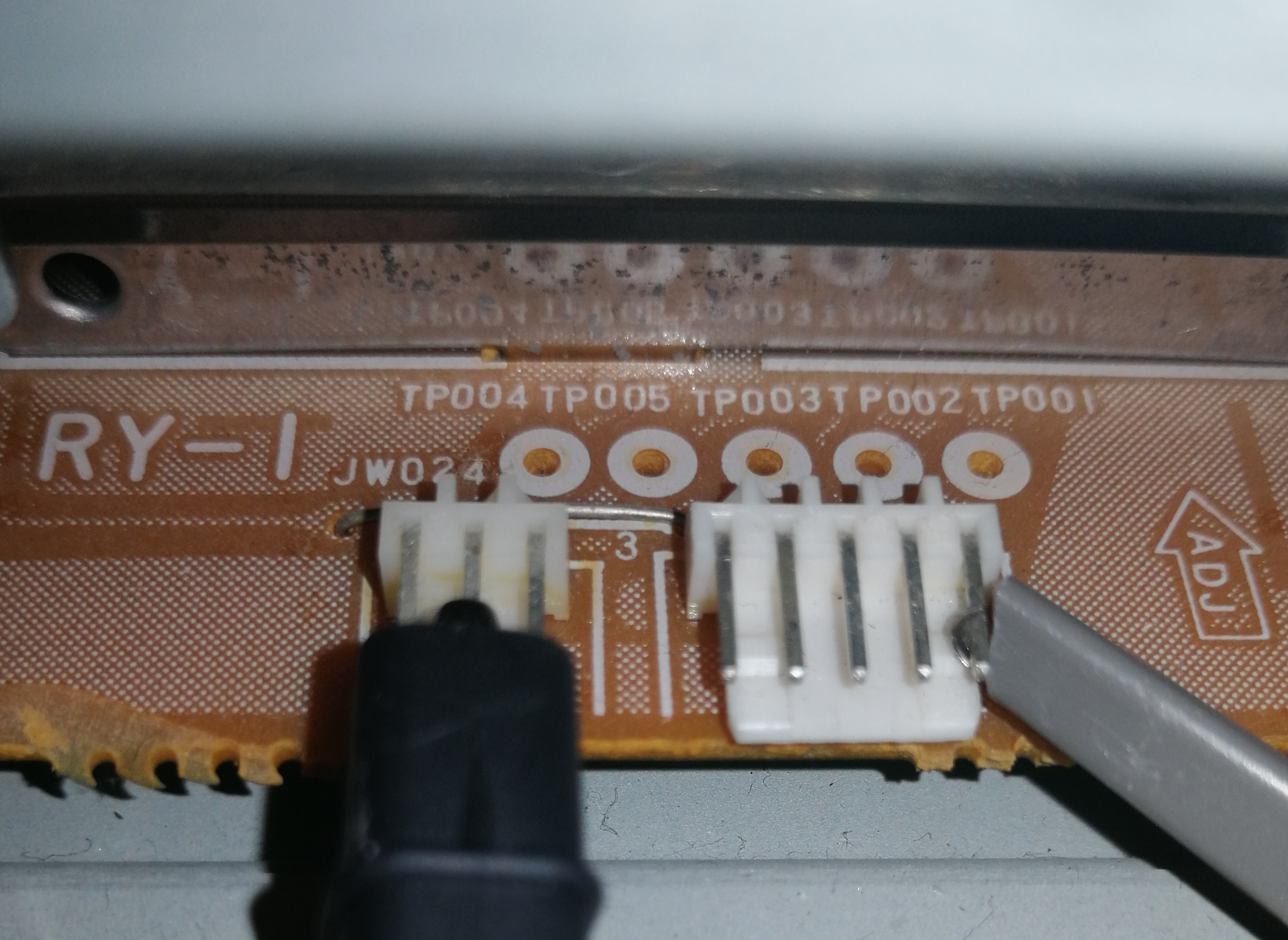
Test points on the left side of the main board, there is a 3 pin header and a 5 pin header.
-
Pin 5 - Video RF
-
Pin 2 - Ground
E is Europe model, UB is UK I think? CN3 on the underside of the video sub-board
Note, The numbering in the schematic/block diagrams seems to be the inverse of the numbering on the pcb diagram and on the actual silk-screening on the pcb. Pin4 is clearly ground, not pin 2.
- PB CTL
- RF SW(2)
- PB Y-RF (video RF)
- GND
- RF SW(1)

The SL-2000 is the US version of this, may or may not have the same connector. See also notes on betamax palsite about unit for servicing notes (important to replace caps in TT-F1 tuner/timer/power supply module if not done already and that is used.)
http://www.palsite.com/slf1tech.html
RF info:
Video RF tap points are located near the head drum:
- Pin 3 signal
- Pin 4 ground
If signal is low, turning knobs to the right of tap points and returning to their original positions may improve output.
Capture/processing issues:
Captures from recordings that have HiFi audio result in bright video output with vhs-decode.
Captures from recordings with linear audio result in normal expected video levels, although luminance shifts appear to cause tbc disruptions.
Various captures attached for reference with variable info in file names








8mm camcorders can be finnicky and not all units deal with having a load connected to the RF test point very well, so do not expect smooth sailing here without reading the hardware guide as a decoupling cap (10uf) can be required.
If you have no experience with soldering/electronics attempting to do RF capture of 8mm may therefore prove challenging. VCRs tend to be easier to work with but those tend to be very expensive and also usually require a fair bit of service as many of the models often have issues with both electronics and mechanical faults.
Sony's newer 8mm camcorders can already give excellent results with lossless conventional capture (Via S-Video) if cleaned and in good head condition so the gains from FM RF capture may not be as large as with other formats as there is no VBI data from camcorder media, however for deck recorded Video8/Hi8 this might not apply but RCTC data can only be easily extracted via FireWire.
Also Applys to, DCR-TRV738E, DCR-TRV740, and DCR-TRV740E.
NOTE: May require 10uf cap, DCR-TRV740 does.
Jig Method 20pin Jig Used

At the back of the camcorder, battery area, there is a rubber or plastic grommet once removed exposes the Jig connection point for testing.

-
Pin 5 - PB RF (Video/Audio)
-
Pin 6 - Ground



-
Pin 6 - PB RF (Video/Audio)
-
Pin 5 - Ground
16-pin JIG
Pin 3 - Signal
Pin 4 - Ground
Requires Capacitor In Line


20 Pin Jig
Pin 5 - Signal
Pin 6 - Ground



16-pin JIG
OEM JIG CPC jig connector (J-6082-539-A)
Pin 2 - Signal
Pin 6 - Ground




Apply's to DCR-TRV360/TRV361/TRV460/TRV460E/TRV461E.
16-pin JIG
Pin 2 - Signal
Pin 6 - Ground


Pin 6 (REG GND)
Pin 5 (RF PB)
Connector CN910 on board VC-213. No internal capacitor.
20 pin Jig Board, 47 uF external capacity added to jig board.
Sony DCR-TRV210E = 1 kOhm Output Impedence
DCR-TRV103/TRV110/TRV110E/TRV110P/TRV203/TRV210/TRV210E/TRV310/TRV310E/TRV310P/TRV315/DCR-TR7000/TR7000E/TR7100E
All share the same service manual. So this information might be true for all of those



Right-hand side of the mech, connector CN402
Standard 2.54mm header pins used.
Pin 1 - Ground
Pin 3 - PB RF
Pin 4 - PCM PB (Hi8 Models Only)



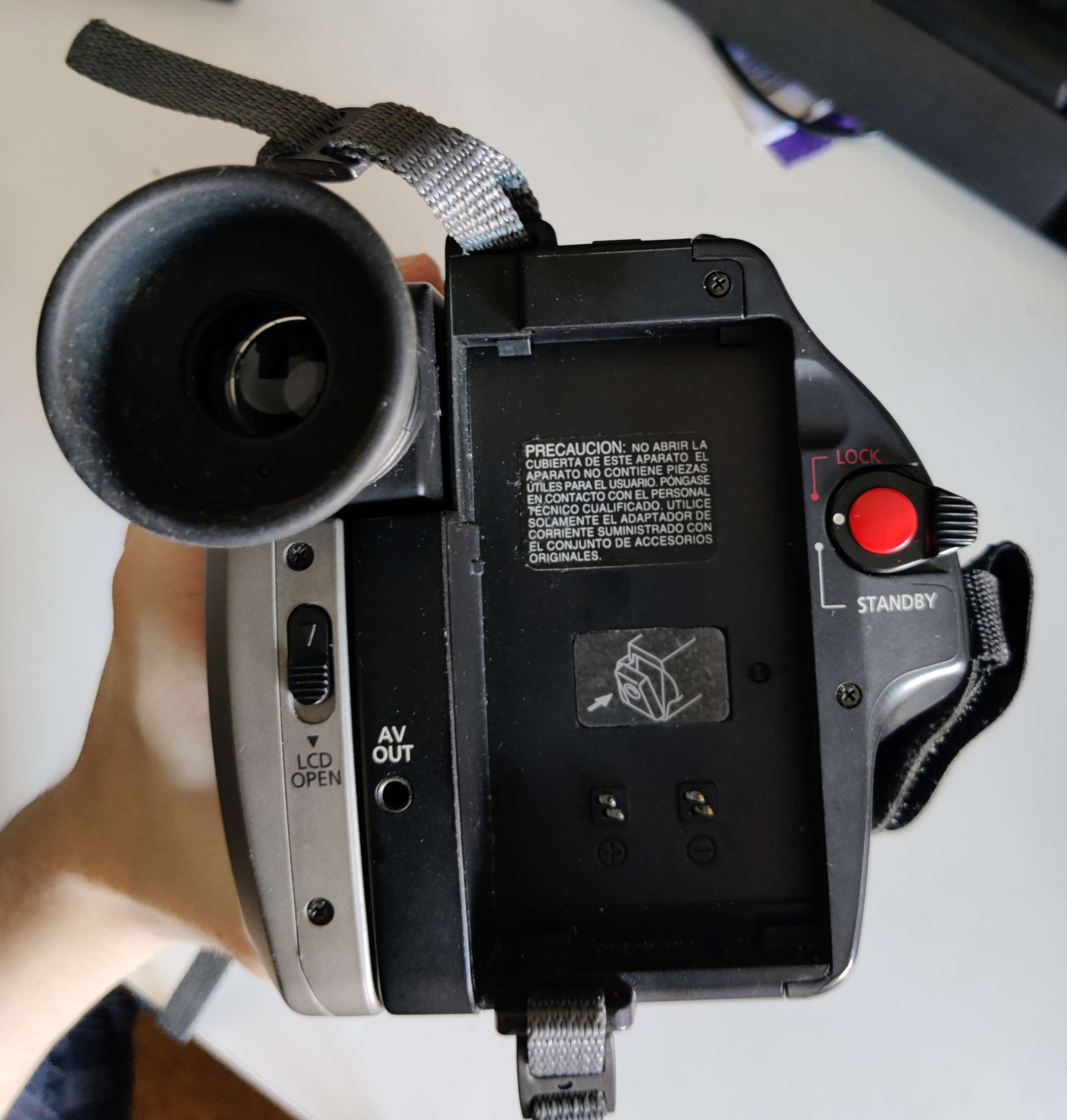


jig connector: 3710-000413
https://es.farnell.com/en-ES/samtec/fte-107-03-g-dv/header-0-8mm-2x7way-smt/dp/3668177
CONNECTOR-SOCKET;14P,2R,0.8mm,STRAIGHT,S
XR Era Camcorder
Pin 5 - Signal
Pin 6 - Ground



FPC adapter is six pin and secured to to the battery by Gorilla double sided tape to strain relief the fpc
10uF NP cap on pcb, but I have not experimented with other values much. 4dB gain on DdD appears optimal.
(numbered 1-16 from top)
Pin 6 is Signal
Pin 8 is Ground



Jig Method 16pin Jig + Cap Used (Appears to require external amplification on inital testing)




XR Era Camcorder
16 Pin Jig
Pin 6 - Signal
Pin 8 - Ground
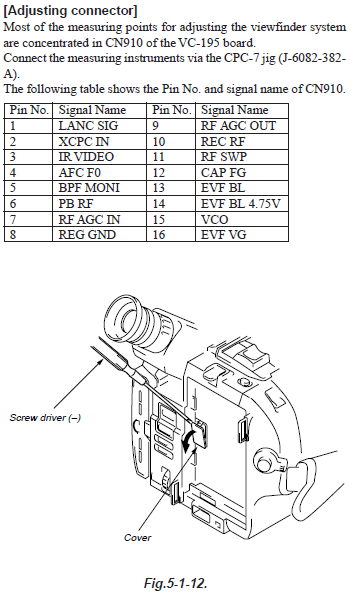



Pin 1 (GND)
Pin 7 (PB RF)
Sony EV-S1000E = 1 kOhm - Output Impedence
Connector CN005 on board RP-74 behind the mechm, no internal capacitor.


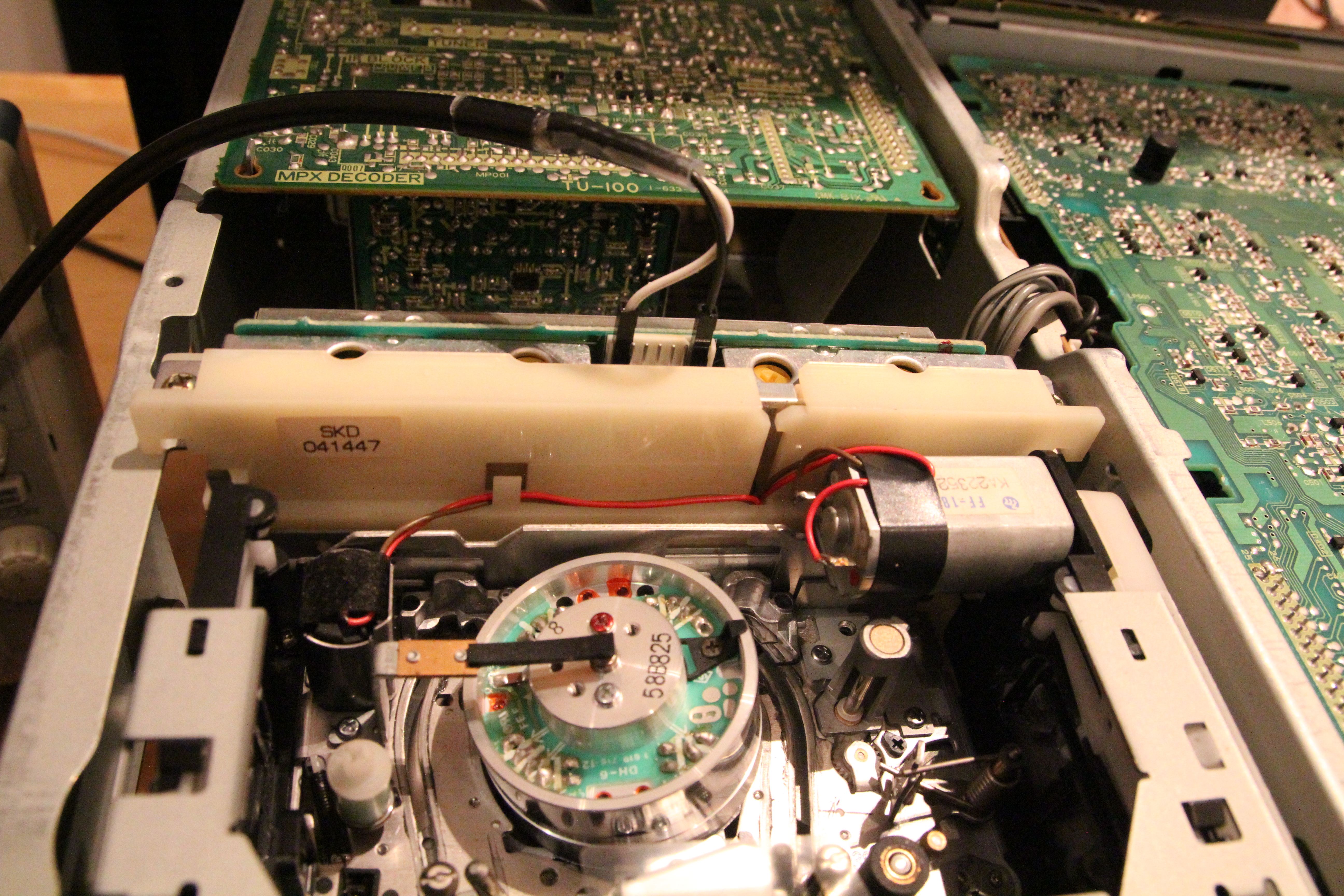
Pin 1 (GND)
Pin 3 (PB Y)
Sony EV-S9000E = 1.3 kOhm - Output Impedence
Connector CN001 on board RP-165, no internal capacitor.

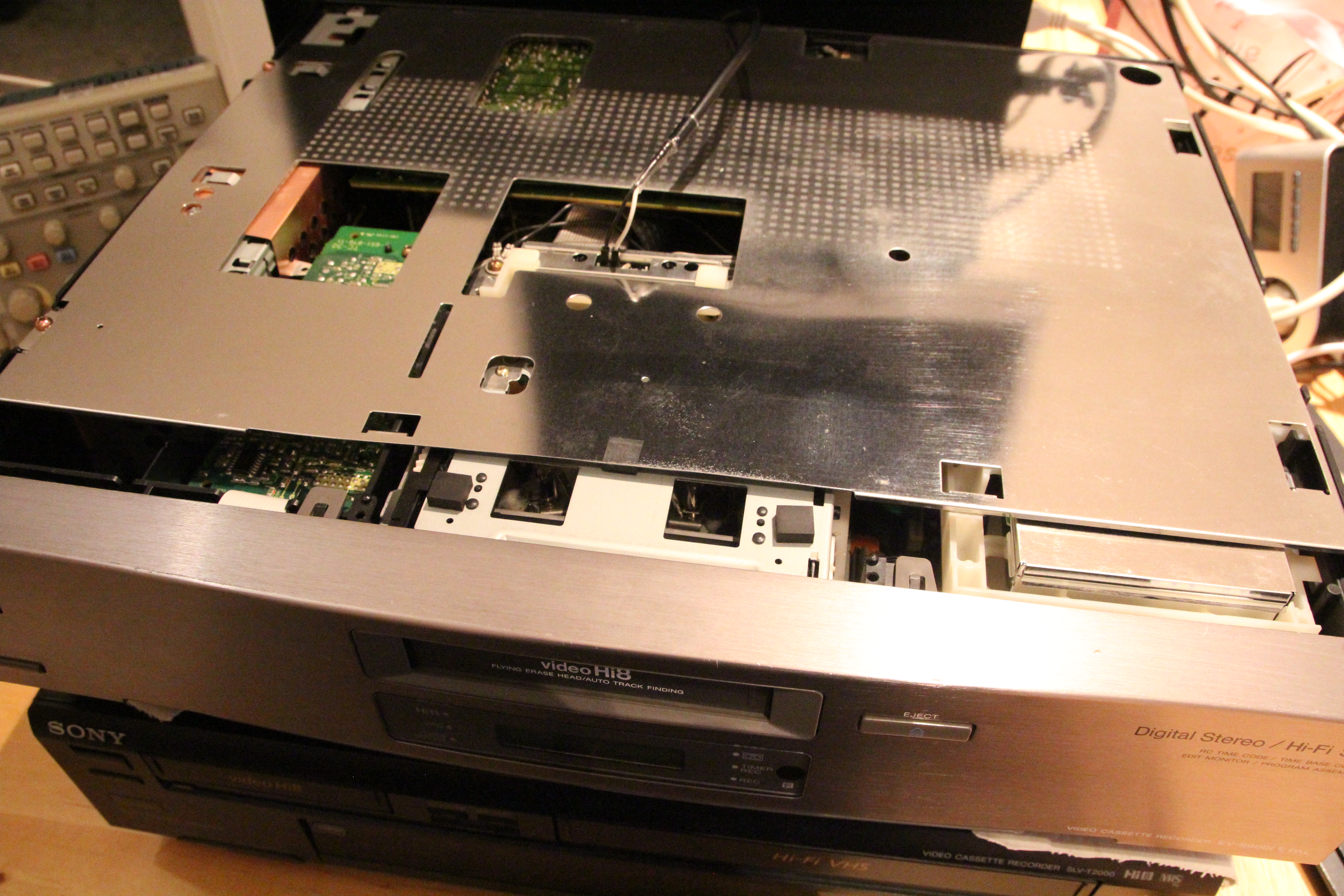





These are video-tape formats that were used in broadcasting and prosumer production this ranges from 2" Quad to Umatic the only pro level colour-under format, ware as formats like SMPTE-C are closer to LaserDisc.
Formats like BetaCam have chroma/luma separated tracks for notable example.
There is two types of Umatic decks standard Umatic with Lo-Band PAL/NTSC and Hi-Band PAL and then the later to last generation decks with Umatic SP with HiBand PAL/NTSC.
Should apply to NTSC / PAL / SECAM versions.
Tap point is TP29 on board YD.



Tri-standard Umatic Deck (NTSC / PAL / SECAM).
Video RF tap point is TP18 on board RP-8B.



Wildly found in UK/USA/France
Sony BVH-3100 (Applies to NTSC/PAL/SECAM versions)
Behind the control panel the first card on the top, number 7 VO-16
First test point is on the left hand side TP12 is video FM no capacitor required on initial testing.
Behind the control panel, you can access a RF test point on the top board (VO-16). It's the first thing on the left, called TP12.
RF Captures have been made without caps, more testing required.

Test Point Location:

Widely found in Germany/Mainland Europe
Decks Yet to be tapped and tested
These are formats that are non-cassette based like film reels and are manually laced onto a take-up reel for playback or recording, and pre-dates most formats you will see or know about in most common use.
EIAJ is the open-reel predicator format to consumer videotape using standard 1/2 magnetic tape.
1960's to 1970s prosumer/commercial recording on the lower end and consumer end.
Take the VTR out of its wooden box, Board V3 is located at the front of the machine.
Test point TP207 is located in the middle of the board. It's called TP207 in the manual, though on the board it may just be called "TP7". The point is located directly to the right of the text.
Use a capacitor, especially if you want to monitor the composite output at the same time otherwise, the RF level will collapse.




Decks Yet to be tapped and tested
TO DO
- FAQ - Frequently Asked Questions
- Diagram Breakdowns
- Visual-Comparisons
- VCR Reports / RF Tap Examples
- Download & Contribute Data
- Speed Testing
- Visual VBI Data Guide
- Closed Captioning
- Teletext
- WSS Wide - Screen Signalling
- VITC Timecode
- VITS Signals
- XDS Data (PBS)
- Video ID IEC 61880
- Vapoursynth TBC Median Stacking Guide
- Ruxpin-Decode & TV Teddy Tapes
- Tony's GNU Radio For Dummies Guide
- Tony's GNU Radio Scripts
- DomesDay Duplicator Utilities
- ld-decode Utilities


